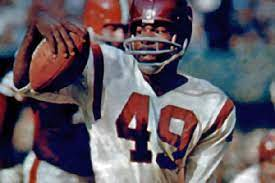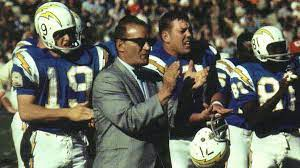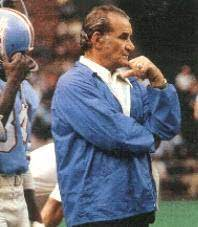Siegman, Joseph M. (1992). The International Jewish Sports Hall of Fame. S.P.I. Books. p. 113. ISBN 9781561710287 – via Google Books.
"Sid Gillman". www.jewishsports.net. Retrieved December 23, 2024.
Tobias, Todd. "An Interview with Sid & Esther Gillman". Tales from the AFL. Retrieved December 24, 2024.
"Sid Gillman | Pro Football Hall of Fame". pfhof. Retrieved December 24, 2024.
Lawson, Earl (October 8, 1955). "Football's Man Without Mercy". Saturday Evening Post.
Peterson, Bill (August 16, 2006). "Cincinnati's Connection to Football's "West Coast Offense"". City Beat. Archived from the original on January 28, 2007. Retrieved September 7, 2006.
"Sid Gillman, College Football Hall of Fame". cfbhall.com.
Farmer, Sam (January 4, 2003). "Coach Revolutionized Offenses in Football". Los Angeles Times. Retrieved December 24, 2024.
Bach, John. "Sports -- Sid Gillman transformed football with film". University of Cincinnati. Retrieved December 24, 2024.
"Sid Gillman has coaching, pro offers for 1934 season". Minneapolis Star. February 19, 1934. Retrieved May 27, 2021 – via Newspapers.com.
Dalton, Ernest (August 25, 1934). "Seven Redskins missing from opening practice". The Boston Globe. Retrieved May 27, 2021 – via Newspapers.com.
"Redskin recruits arrive at Wayland camp today". The Boston Globe. September 3, 1934. Retrieved May 27, 2021 – via Newspapers.com.
"Sid Gillman, Cradle of Coaches: A Legacy of Excellence". spec.lib.miamioh.edu.
"'Way ahead of his time'". The Columbus Dispatch. Retrieved December 24, 2024.
Zimmerman, Paul (July 1, 2016). "Best of Dr. Z: 1991 Sid Gillman feature". Sports Illustrated. Retrieved February 16, 2024.
Katzowitz, Josh (2012). Sid Gillman Father Of The Passing Game. Clerisy Press. pp. 85–86, 150–178. ISBN 978-1-57860-505-7.
"Ara Parseghian (1980) - Hall of Fame". National Football Foundation. Retrieved December 24, 2024.
"Cincinnati Bearcats History - College Football". www.collegefootballhistory.com. Retrieved December 24, 2024.
"100 Figures Who Shaped the NFL's First Century". SI. August 28, 2019. Retrieved December 24, 2024.
Wallace, William N. (January 4, 2003). "Sid Gillman, 91, Innovator Of Passing Strategy in Football". New York Times.
"Los Angeles Rams Team Records, Leaders, and League Ranks". Pro-Football-Reference.com. Retrieved December 24, 2024.
Murray, James. "Cleveland Won the Title Again But Not Before the Whole NFL Had Come to Appreciate Coach Sid Gillman and His L.A. Rams". Sports Illustrated Vault. Retrieved February 16, 2024.
"Andy Robustelli | Pro Football Hall of Fame". pfhof. Retrieved December 24, 2024.
Gomez, Johnny (August 23, 2013). "1956: Andy Robustelli traded; Rams' fortunes change - Rams Talk". Retrieved December 24, 2024.
"1960 Philadelphia Eagles, Only team to beat Vince Lombardi in the playoffs, NFL 100". NFL.com. Retrieved December 24, 2024.
"Van Brocklin, at Odds With Ram Coach, Is Traded to Eagles in Football Deal". New York Times. May 27, 1958.
"This I Remember: Elroy Hirsch". University of Michigan Athletics. Retrieved December 24, 2024.
Gomez, Johnny (August 23, 2013). "1959: The Gillman era falls flat - Rams Talk". Retrieved February 16, 2024.
Tracy, Marc (February 3, 2011). "How Three Jews Behind the AFL Invented the Modern Media Spectacle That is Pro Football Today". Tablet Magazine. Retrieved December 24, 2024.
"Los Angeles Chargers Team Records, Leaders, and League Ranks". Pro-Football-Reference.com. Retrieved December 24, 2024.
Elwood, Hayley (September 20, 2019). "Remembering Chargers Founding Owner Barron Hilton". www.chargers.com. Retrieved December 24, 2024.
Gardner, Sam (January 12, 2017). "Original Charger remembers when the team called Los Angeles home". FOX Sports. Retrieved December 24, 2024.
"Ailing Leahy Quits Charger Post". New York Times. July 2, 1960.
"Head Coach, Sid Gillman, NFL 100". NFL.com. Retrieved December 24, 2024.
"Al Davis | Pro Football Hall of Fame". pfhof. Retrieved December 24, 2024.
Katzowitz, Josh (2012). Sid Gillman Father Of The Modern Passing Game. Crerisy Press. p. 184. ISBN 978-1-57860-505-7.
Tobias, Todd. "Dickie Post - February 17, 2004". Tales from the AFL. Retrieved February 16, 2024.
"Dickie Post Stats, Height, Weight, Position, Draft, College". Pro-Football-Reference.com. Retrieved December 25, 2024.
"Dave Kocourek Stats, Height, Weight, Position, Draft, College". Pro-Football-Reference.com. Retrieved December 25, 2024.
"Dave Kocourek Discusses Sid Gillman's Offense". talesfromtheamericanfootballleague.com.
Shrake, Edwin (December 13, 1965). "They All Go Bang! At Bambi". Sports Illustrated. Vol. 23, no. 4.
"Detroit Free Press from Detroit, Michigan". Newspapers.com. October 19, 1966. Retrieved February 16, 2024.
Shrake, Edwin (September 13, 1965). "San Diego Chargers". Sports Illustrated Vault. Archived from the original on August 11, 2022. Retrieved December 25, 2024.
Shrake, Edwin (January 24, 1966). "Big rookie bonuses start a battle, Annoyed by the vast sums paid untried players, two San Diego All-Stars are bidding for $1 million". Sports Illustrated.
"Chargers Trade Faison And Ladd For Three Oilers". New York Times. January 16, 1966.
Rathet, Mike (January 20, 1966). "Commissioner Voids Trade Between Oilers, Chargers". El Paso Times. p. 22.
Fitzgerald, Tommy (May 2, 1966). "Dolphins Won't Deal For Faison Or Ladd". The Miami News. pp. 25A.
Braucher, Bill (October 20, 1966). "Dolphins Catch Charger Faison". The Miami Herald. pp. 2-D.
Tobias, Todd. "An Interview with the San Diego Chargers John Hadl". Tales from the AFL. Retrieved February 16, 2024.
"1960 Los Angeles Chargers Rosters, Stats, Schedule, Team Draftees". Pro-Football-Reference.com. Retrieved December 24, 2024.
"1961 San Diego Chargers Rosters, Stats, Schedule, Team Draftees". Pro-Football-Reference.com. Retrieved December 24, 2024.
"Jack Kemp | Pro Football Hall of Fame". pfhof. Retrieved December 24, 2024.
"Championship - Los Angeles Chargers at Houston Oilers - January 1st, 1961". Pro-Football-Reference.com. Retrieved December 24, 2024.
"Championship - Houston Oilers at San Diego Chargers - December 24th, 1961". Pro-Football-Reference.com. Retrieved December 24, 2024.
"Gold Jacket Spotlight: Grace, Speed Defined Lance Alworth | Pro Football Hall of Fame". pfhof. Retrieved December 24, 2024.
"Way Back When: A quarterback's path". www.denverbroncos.com. Retrieved December 24, 2024.
"Jack Kemp Stats, Height, Weight, Position, Draft, College". Pro-Football-Reference.com. Retrieved December 24, 2024.
"1962 AFL Draft Listing". Pro-Football-Reference.com. Retrieved December 24, 2024.
"1963 San Diego Chargers Rosters, Stats, Schedule, Team Draftees". Pro-Football-Reference.com. Retrieved December 24, 2024.
"1963 Awards Voting". Pro-Football-Reference.com. Retrieved December 24, 2024.
"Championship - Boston Patriots at San Diego Chargers - January 5th, 1964". Pro-Football-Reference.com. Retrieved December 24, 2024.
Center, Bill (July 11, 2014). "Sid Gillman helped put AFL on the map". San Diego Union-Tribune. Retrieved December 24, 2024.
"Ron Mix | Pro Football Hall of Fame". pfhof. Retrieved December 24, 2024.
"Speedy Duncan Stats, Height, Weight, Position, Draft, College". Pro-Football-Reference.com. Retrieved December 24, 2024.
"Kenny Graham Stats, Height, Weight, Position, Draft, College". Pro-Football-Reference.com. Retrieved December 24, 2024.
"Dick Westmoreland Stats, Height, Weight, Position, Draft, College". Pro-Football-Reference.com. Retrieved December 24, 2024.
"Frank Buncom Stats, Height, Weight, Position, Draft, College". Pro-Football-Reference.com. Retrieved December 24, 2024.
"Hall of Famer Ron Mix on Sid Gillman". Tablet Magazine. April 19, 2017. Retrieved December 24, 2024.
"Hank Stram Record, Statistics, and Category Ranks". Pro-Football-Reference.com. Retrieved December 25, 2024.
"Sid Gillman Record, Statistics, and Category Ranks". Pro-Football-Reference.com. Retrieved December 25, 2024.
"Gillman Resigns as Chargers' Coach". New York Times. November 23, 1971.
Marshall, Joe. "After 18 Dry Wells, A Little Gusher". Sports Illustrated Vault. Retrieved February 16, 2024.
Wallace, William N. (October 16, 1973). "Peterson Is Ousted By Oilers". The New York Times. ISSN 0362-4331. Retrieved February 16, 2024.
"Remember When: Bud Adams hires Bum Phillips; Sid Gillman quits". CBSSports.com. October 25, 2013. Retrieved February 16, 2024.
Farrar, Doug (October 19, 2013). "Remembering Bum Phillips, the unsung defensive innovator". SI. Retrieved December 25, 2024.
"1974 Houston Oilers Rosters, Stats, Schedule, Team Draftees". Pro-Football-Reference.com. Retrieved December 25, 2024.
"Curley Culp | Pro Football Hall of Fame". pfhof. Retrieved December 25, 2024.
"Packers Get Hadl". New York Times. October 23, 1974.
"Sid Gillman dies at 91 - UPI.com". UPI. Retrieved December 25, 2024.
"Celebrating Hall of Fame coaches on National Coaches Day | Pro Football Hall of Fame". pfhof. Retrieved December 25, 2024.
"Robert Brazile | Pro Football Hall of Fame". pfhof. Retrieved December 25, 2024.
"1975 Houston Oilers Rosters, Stats, Schedule, Team Draftees". Pro-Football-Reference.com. Retrieved December 25, 2024.
Pierson, Don (January 4, 2003). "Sid Gillman 1911-2003". Chicago Tribune.
Frank, Reuben (January 31, 2024). "Ranking the top 10 coordinators in Eagles history". CSNPhilly.
Barkowitz, Ed. "BRIEF: Jaws fondly recalls Sid Gillman, his mentor". Erie Times-News. Retrieved December 25, 2024.
Domowitch, Paul (August 6, 2021). "The wait is over. Harold Carmichael finally goes into the Hall of Fame". www.inquirer.com. Retrieved December 25, 2024.
"Harold Carmichael | Pro Football Hall of Fame". pfhof. Retrieved December 25, 2024.
"Oklahoma Outlaws to Join USFL". Chicago Herald. July 8, 1983. p. 22.
"Quarterback Doug Williams says his move from the Tampa... - UPI Archives". UPI. Retrieved December 25, 2024.
"Super Bowl XXII - Washington Redskins vs. Denver Broncos - January 31st, 1988". Pro-Football-Reference.com. Retrieved December 25, 2024.
"Outlaws Move Gillman Out". The Oklahoman. Retrieved December 25, 2024.
Schwab, Frank (June 24, 2016). "The crazy story behind Steve Young's crazy 43-year USFL contract". Yahoo Sports. Retrieved December 25, 2024.
"Steve Young - USFL (United States Football League)". www.usflsite.com. Retrieved December 25, 2024.
"Randall Cunningham Stats, Height, Weight, Position, Draft, College". Pro-Football-Reference.com. Retrieved December 25, 2024.
Katzowitz, Josh (2012). Sid Gillman Father Of The Passing Game. Clerisy Press. pp. 259–64. ISBN 978-1-57860-505-7.
"Sid Gillman Coaching Tree · Cradle of Coaches". spec.lib.miamioh.edu. Retrieved December 25, 2024.
"George Blackburn College Coaching Records, Awards and Leaderboards". College Football at Sports-Reference.com. Retrieved December 25, 2024.
"In Memory of Paul Dietzel | Walter Havighurst Special Collections, The University Archives & Preservation". October 4, 2013. Retrieved December 25, 2024.
"Paul Dietzel College Coaching Records, Awards and Leaderboards". College Football at Sports-Reference.com. Retrieved December 25, 2024.
"Honoring a legend". Your Observer. October 2, 2014. Retrieved December 25, 2024.
"Chuck Noll Record, Statistics, and Category Ranks". Pro-Football-Reference.com. Retrieved December 25, 2024.
Oates, Bob (January 4, 2003). "Gillman Had Other Love in Life". Los Angeles Times. Retrieved March 11, 2022.
"Dick Vermeil | Pro Football Hall of Fame | Pro Football Hall of Fame". pfhof. Retrieved December 25, 2024.
"Dick Vermeil Record, Statistics, and Category Ranks". Pro-Football-Reference.com. Retrieved December 25, 2024.
"George Allen Record, Statistics, and Category Ranks". Pro-Football-Reference.com. Retrieved December 25, 2024.
"Way Back When: How Sid Gillman's coaching tree extends from LA to Denver". www.denverbroncos.com. Retrieved December 25, 2024.
"Coryell, Gibbs' Mentor For Many Years, Passes Away". www.commanders.com. Retrieved December 25, 2024.
Union-Tribune, Tom Krasovic | The San Diego (July 29, 2019). "Tom Bass, who coached under Coryell and Gillman, dies at 83". San Diego Union-Tribune. Retrieved December 25, 2024.
"Sid Gillman Coaching Tree". Retrieved December 18, 2014.
"Sid Gillman | Pro Football Hall of Fame". pfhof. Retrieved December 25, 2024.
"Sid Gillman (1989) - Hall of Fame". National Football Foundation. Retrieved December 25, 2024.
"Sidney Gillman (1981) - Hall of Fame Inductees". Ohio State. Retrieved December 23, 2024.
"Sid Gillman (1981) - University of Cincinnati James P. Kelly Athletics Hall Of Fame". University of Cincinnati Athletics. Retrieved December 25, 2024.
"Los Angeles Chargers". www.chargers.com. Retrieved December 25, 2024.
"Southern California Jewish Sports Hall of Fame Home". scjewishsportshof.com.
"Sid Gillman (1991) - Hall of Fame". Miami University RedHawks. Retrieved December 25, 2024.
Martin, Susan (January 4, 2003). "Legendary Gillman dies at 91". Buffalo News. Retrieved January 15, 2021.
"Gillman Helped Engineer West Coast Offense". ESPN.com. Associated Press. January 7, 2003. Retrieved April 11, 2020.


















